|
I used to fish two beautiful rivers. They were
so clean and rich with aquatic life. If you stood
in one spot for a couple of minutes, gray-olive
Sowbugs would cover the toes of your boots. Brown
scuds scampered from rock to rock and several
invaded the crevice between my waders and boots.
Their fish were large, healthy, colorful, and
fought with heart. The streambeds were filled
with clean tan gravel, yellow sandy eddies, and
chalk gray bedrock shoals. Lush, emerald Coontail
Moss was downstream of their islands and schools
of mirror skinned minnows scoured their shallows.
Craneflies, fishflies, mayflies, dobson flies,
caddis, and midges danced on their silver surface.
Their misty morning perfume was intoxicating and
invited the fisherman.
These rivers that I loved so much are very different today.
After 25 years of guiding the White River below
Bull Shoals Dam and the North Fork of the White
River below Norfork Dam, I can say that I have
seen the water quality, river ecology, and general
habitat deteriorate dramatically. The evidence of
organic pollution overwhelms the alert fisherman
and a microscope is not needed to find it.
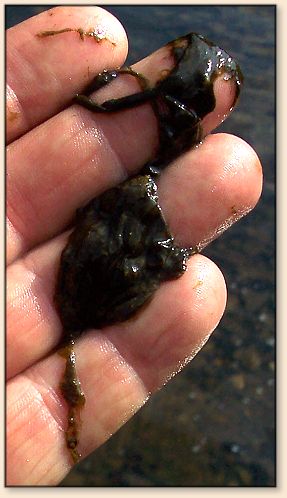
The streambeds that were once filled with tan to
slate colored gravel are now coated with dead,
black-olive gunk that has the consistency of cow
manure. This gunk is so plentiful that it covers
the large rocks that are in the current as well
as the rest of the bottom. The sandy eddies are
worse. The pollutant is several inches thick in
these areas to the point that the Coontail Moss
beds are disappearing or are already gone. The
light gray bedrocks that once dotted our streambeds
are now undistinguishable from the rest of the dark
green bottom. The free-stone habitat that the
sowbugs once thrived in is now silted to the point
that only a handful of them can be found in the
entire North Fork and barely more are in the White.
Other aquatic insects have disappeared as well.
Several species of mayflies, midges, blepharocera
(net-veined midges), and caddis along with craneflies,
dobson flies, fish flies, water pennies, water beetles,
in the upstream area of the White and all of the North
Fork gilled snails (right opening) and others are long
since absent from our waters. Today only the
callibaetis mayflies, burrowing caddis, planarian,
scuds, sowbugs, oligochaete worms, leeches, in some
areas lunged snails (left opening), and a few midge
species are present. Several of the other aquatic
species are quickly disappearing. With the extinction
of a species due to the escalating degree of pollution,
the food web of our streams offers less and less to
feed all of our fish. This includes minnows, suckers,
sculpins, bass, and sunfish, as well as the trout that
we value so much. With the sowbugs approaching extinction
in our water, what species will be next?
This being a high-water year and a cooler than
normal summer, one would expect that our bug
populations would have been revitalized. However,
this is not the case. Instead of clean gravel
bottoms and hoards of bugs, the conditions are
quite the opposite. The polluted state of our
rivers is approaching "grossly polluted" conditions
swiftly and the bug population is less than ample.
This is very evident at Rim Shoals Catch-N-Release
Area where the trout are filled with snails, not
scuds or sowbugs. Their bellies feel as though
they have been eating marbles and it is possible
to see the roundness of the snail shells in their
stomachs. Reports of "good fishing" have come
from all parts of the rivers, but this does not
reflect the condition of the fish. It simply
means that the fish are hungry and are eating to
fill themselves. They may not be getting enough
to eat. Even with a full stomach of snails the
fish are still hungry. Remember a "satisfied" fish
does not eat, while hungry fish do. Bad fishing days
are often attributed to the fish being filled and
satisfied. This is the situation after the first
three hours of one of our winter shad kills. The
fish stop feeding for two or three days because
they are packed with high protein dead Threadfin
Shad.
The polluting of these rivers has not come upon
them suddenly, but has amplified yearly for the
last 15 years. The growth rates of the Rainbow
Trout are a testament to this. Less than 10 years
ago the Arkansas Game and Fish boasted of growth
rates of 6 inches a year in the White and 12 inches
a year in the North Fork. Today, according to
Darrell Bowman, AG&F Trout Biologist, the growth
of our rainbows is less than one inch a year at
Rim Shoals Catch-N-Release Area and 2.69 inches
in the North Fork Catch-N-Release. The numbers
and size of our rainbows has also decreased within
this same time period. Tom Rogers
(https://www.whiteriver.net/tnt/), a long time friend
and guide, said to me this week that there use to
be as many as eight times the fish in the North Fork.
Why are the rainbows' growth rates dwindling? Simple,
there are less food items for them to consume, fewer
sowbugs, scuds, planarian, midges, caddis, mayflies,
minnows, sculpins, small trout, and others. With the
pollution of the aquatic environment all species of
our rivers' ecology are affected. With the
advancement of pollution becomes the threat of
toxic die-offs of every valued species within our
waters because of high PH level, oxygen depletion
and other problems. Believe me, the problems with
our bug populations is not caused by rising water
traveling over hot gravel it is the quality of
our water and the polluting of our streambeds.
The very life-blood of our rivers is the culprit.
With each drop of water that is discharged into
our rivers come the pollutants that are contained
within it. As the pollution escalates in our lake
so does the amount of pollution carried within each
drop. This is evident because the pollution begins
at the dams and not downstream.
What evidence do I have for these claims?
Let's start with the North Fork River. The North
Fork starts in Missouri as a warm water runoff stream.
As it meanders through the Ozarks, five out of the
seven largest springs in Missouri change this river
into a cold water stream. Constance Whiston
(https://www.constanceflyfishing.com/), over 25 yrs
experience, guide service, presentations, FFF casting
instructor, professional outdoor writer), recently
floated this area and here is a quote from her.
"I did some over nights paddling down the river
alone from the upper sections down to Sunburst
Ranch which is almost to Dawt Mill. The nasty
floating gobs of green started around all the
houses in the cold trout water, which is what
I would call the lower sections. The warm
water/upper areas were pristine and not as
inhabited people/houses...hence run off. I moved
here a river zealot belonging to many conservation
organizations in Texas and remain a river zealot.
The gobs of green were so bad it was cast and clean,
cast and clean."
I had a conversation with John Gulley
(https://www.flyguide.com/services.php) this past
week. John has been guiding the White and North
Fork for over thirty years. He knows every nook
and cranny of these rivers. He sited several
examples of the pollution in both rivers. The
green gunk covering the bottoms, the disappearance
of the sowbugs and other species, the dying of the
coontail moss and other aquatic plants, the die-offs
of the scuds, and more. John told of us of the
decline in the sowbug population over four years ago.
The Environmental Protection Agency (EPA) released
a bulletin earlier this month that stated their
random sampling of the lakes and rivers in the USA
revealed high levels of mercury in fish taken from
Norfork Lake. This was aired on CNN News, broadcasted
on KTLO radio station in Mountain Home, and published
in the Arkansas Gazette. While mercury's natural
occurrence in all waters is due to airborne molecules
precipitated out with rain, several other mercury
contributing methods are at work in the White River
System. All oil products contain some mercury
contamination. Two-cycle outboard motors use 25%
of the gas-oil mixture for lubrication and this
is deposited within our lakes and rivers. As the
gas-oil mixture floats on the surface of the water
it is broken down by sunlight, it melts. During
the melting process the lightest molecules and
elements disperse into the air while the heaviest
molecules and elements sink to the bottom of our
lakes. Mercury is more than ten times heavier
than water. Some of the protein used in livestock
feeds for cattle, chicken, and even farm raised
fish is derived from crude oil. Crude is also
laced with the element mercury. As agriculture
runoff is deposited in our river and lakes it
brings with it heavy metals. Fertilizers,
fungicide products, and lead contain mercury.
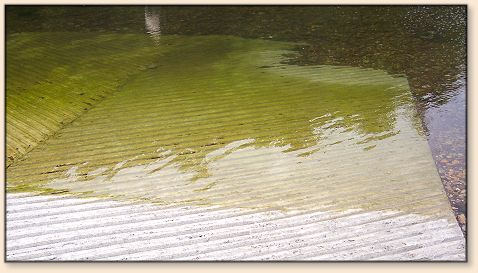
I have an interesting picture that shows the
amount of pollutants in the North Fork River.
The picture above is of the new boat ramp below
Norfork Dam. I guess you are wondering what this
is supposed to illustrate. The pad on the right
of the launch is less than one day old. Notice
the green gunk that is already deposited on it
from one short generation cycle. Looks like it
could have been there for months or even years.
If you have the opportunity to fish this area
during the conclave, be sure to check out the
progress of the pollution on this pad.
What evidence is there of the pollutants in the White River?
Let's start at the headwaters of the White in
the Fayetteville area. Northwestern Arkansas
is the fastest growing population, economical,
and industrial area in Arkansas. The U.S. Census
Bureau stated in July of this year that in six
years the Fayetteville area will be larger than
the Little Rock area. With sewage plants running
at their maximum now will they be able to keep up?
Regardless of the increase capacities of the sewage
systems, septic tanks and construction runoff will
increase incredibly. This is going to affect two
major rivers in the Ozarks; the White River to the
north and east and the Illinois to the west and south.
I hope the Oklahoma boys are willing to join the
fight to keep their rivers as clean and beautiful
as they are now. It would be a shame to see the
upper Illinois befall the same shameful abuse as
the White.
The Beaver Lake area is already having problems
with tremendous algae blooms and oxygen depletions.
This is a matter of record and the situation has
finally become a concern for the land owners on
the lake's banks.
The tailwaters of Beaver Lake were the concern of
Skip Halterman more than ten years ago. He spoke
forcefully about the pollution of the upper White
River, Kings River and others. The fishermen of
all types turned a deaf ear to him. As the Eureka
Springs area continued to grow, so have the
contributing polluters and the amount of pollutants
in the area streams.
An article published in the August 15, 2004 Springfield
Sunday News Leader on the pollution levels in the
Kings River is a real eye opener. Due to the phosphorus
levels in the Kings River below Berryville, the algae
bloom is so thick that the bottom can not be seen in
water that is two feet deep. The wastewater treatment
plant at Berryville (with a population of 4,000 people)
processes 2.4 million gallons of sewage each day with
1.3 million being contributed by the Tyson Processing
Plant. The Kings River and its tributaries (War Eagle
Creek, Osage Creek and others) are the home of several
chicken producing operations. Add to this the increase
of septic tanks and you have a much polluted tributary
of the White River System. Also mentioned in this
article are the phosphorus and other pollutants of the
James River of Southern Missouri that flows into Table
Rock Lake. In my book, Fishin' What They See,
on page 25, I discussed the minnow situation in the Kings
River. In the data that I was using eighteen minnow
species are either extricated or rare, and this could
be considerably worsened by now.
Table Rock Lake is beginning to see the results of
large deposits of pollutants from its tributaries
and from its banks. Reports of scum covered banks
and foul smelling, green algae colored water is
common. With the Branson Boom as a major contributor
to the lake's problems it is a wonder that a fish
still live within its depths. It is merely a matter
of time before a major ecological disaster befalls
Table Rock.
The fishes of Lake Tanneycomo may look good in the
summer but come winter time they are emaciated.
This is due to the lower production of bugs.
Bull Shoals Lake has yet to produce visual evidence
of the problems that are masked by its depths.
However, the time is coming when the algae will
discolor its banks if regulations are not placed
to correct the upstream pollution.
The White River below Bull Shoals Dam is another
story. Because the lakes are very similar to
large septic tanks and the discharge into the
river comes from the bottom of the dams, the
heavy pollutants come out with each generation
cycle. To a lesser degree the White is experiencing
the same type of pollution as the North Fork. The
green gunk is covering the bottom and destroying
the freestone habitat quickly. The growth rate
of the rainbows in the Catch-n-Release area is
one inch a year. Just one sixth of what it was
ten years ago. Because I lived just two miles
from the dam for several years and have fished
this area extensively, I have several pictures
of this area.
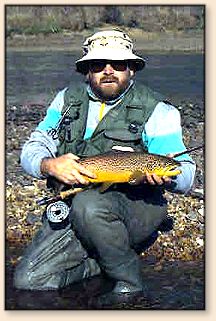
This picture is of the gravel bar at Bull Shoals
State Park. Notice behind me is the wastewater
treatment plant for the city of Bull Shoals. More
importantly pay particular attention to the gravel
that is behind me.
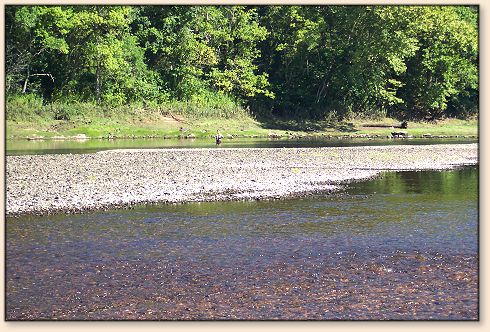
This picture, taken August of 2004, is of the
same area. Notice the white powered deposit
on the gravel. This is phosphorus and lots
of it. Incidentally, during the time period
of the first picture and the second, this gravel
bar was removed for an upstream bank restoration
project above the state park, so all of this
gravel has been washed downstream in the last
few years.
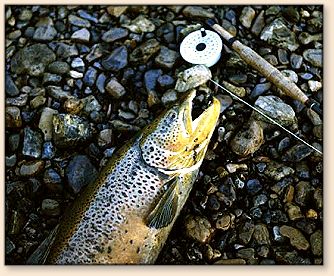
Notice the gravel in this picture. See how clean
and colorful it is. The picture was taken at the
upstream gravel bar at the state park.
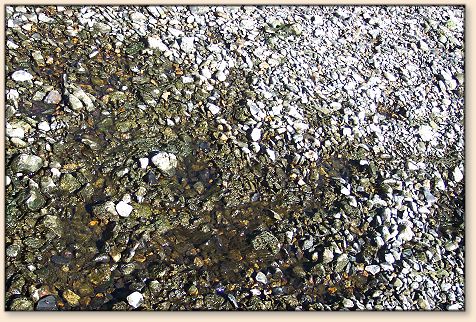
This picture is taken within inches of the first.
Notice the green gunk on the rocks and the white
phosphorus deposit on the gravel. Quite a contrast
between these two pictures, and you thought I was
making this all up.
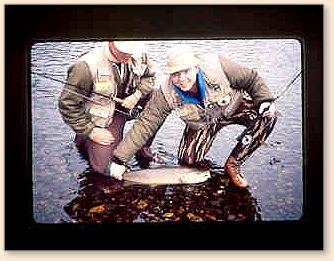
Notice the bottom of the river in this slide.
The bottom is not covered with the green gunk.
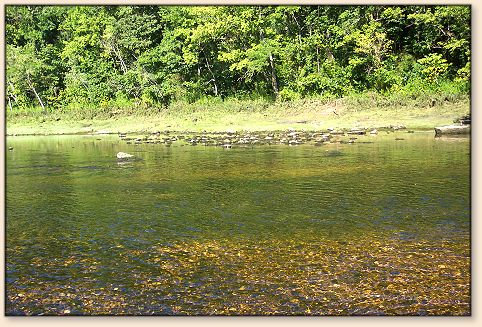
Notice the green gunk that is covering the
streambed now and the phosphorus on the rocks
on the far bank.
I have hundreds if not a thousand pictures of
what the White river used to be. Today, I don't
take pictures of it. I even hate the smell of it.
Like the North Fork, it often has the ammonia
smell of an outdoor toilet.
I have a friend, Vaughn Coomer, who lives in Texas
and has a home on the bluff above Cane Island. Vaughn
has been coming to this area to fish for trout for
nearly twenty years. Vaughn gave this information
to me over the phone during a discussion about the
pollution of the rivers. One of Vaughn's friends
and neighbor built a boat dock on the White River
five years ago. Last year, his friend's boat dock
took an unexpected trip down the river. The reason
the dock took a trip was because the cables that
held it to the bank had been eaten through where
the green gunk had collected on them. The broken
cables were replaced with new stainless steel coated
cables. Guess what? The dock took another unexpected
trip down the river this year. And guess what? The
new cables had been eaten through again in one year
where the green gunk was on them.
Another friend of mine is Jim Miller of Norfork,
Arkansas. Jim is the best midge fisherman that
I know. Jim is meticulous in noticing every aspect
of the midge populations in the White and the North
Fork. He samples the river continuously to keep
up with the size and color of midge to be using.
Recently, Jim told me that the midges in both rivers
are getting noticeably smaller. Midges can live in
extremely polluted areas but there is one thing that
will remove them from a system.
Last year, while guiding at McCellan's on the North
Fork, I had two clients fishing straight out in the
river from the parking area in the pasture. It was
raining lightly but the rain was steadily increasing
until it was slightly less than a downpour. It wasn't
lightning so we elected to stay until the rain got too
heavy. As we were climbing the sandy river bank to
leave, I noticed something very odd. The scuds were
coming out of the river and swimming up the small
streamlets caused by the water dripping out of the
grass. These streamlets, every one of them, were
packed so full of scuds trying to escape the river
that it seemed impossible for them to swim. The
next day we returned to the same area to fish.
To our amazement the scuds had swam in these
streamlets until there was no more water, and
there they had died.
What do these three seemingly unrelated events
have in common? What could a downstream trip
of a boat dock, the growth of midge pupa, and
scuds trying to escape the river share? The
green gunk in our river is extremely acidic which
is driving the PH level in our river up and up.
Phosphoric acid is very potent, strong enough to
eat stainless steel coated cables. The only thing
that will destroy a midge population is a high PH
environment. The scuds were escaping the river
because the streamlets had a lower PH than the
river. All three of these events are scenarios
of what is to come.
What species of bug is going next?
In the White River most likely the sowbugs.
Their numbers are drastically reducing, especially
in the areas nearest Bull Shoals Dam and below
Cotter. I consider the sowbugs in the North Fork
on the verge of extinction. Their habitat has
been destroyed by the green gunk that has filled
the crevices of the gravel.
The Planarian in both rivers is sharing the ills
of the midge. They are getting smaller and fewer.
I attribute this to the higher PH levels in both
rivers due to the green gunk. Planarian are an
"under the rock bug" that prefer a moderately clean
gravel. These areas are disappearing quickly in the
White and are gone in the North Fork.
Scuds prefer the top couple of inches of clean
gravel. The White still has large areas like
this but they are disappearing quickly. Each
time the dams open up more and more organic
pollution is added to the streambed. The North
Fork is worse. There are not a couple of inches
of clean gravel. Usually the surface rocks are
covered with the black-green gunk. In the North
Fork, the scuds are living on the fringe and I
expect to see them die off just after the planarians
and midges.
In the last three years I have observed massive
die-offs of the scuds in the North Fork River;
once three years ago, three times two years ago,
three times last year, and once already this year.
Some fishermen seem to think that this is a natural
occurrence. If it is why isn't it happening in
the White River also?
The minnows in the North Fork are diminishing.
I notice the only places that I see minnows are
at the mouth of creeks or old sloughs, not in
the main river. I can remember when there were
clouds of minnows a below the islands and shallows
along the banks. The number of minnows in the
North Fork once rivaled the number in the upper
Spring River below Dam #3 near Mammoth Springs.
I notice I see hardly any sculpins in the North
Fork now. Their numbers have sharply decreased.
This is also true below Bull Shoals Dam.
Will all of this Organic Pollution
affect Natural Reproduction of the fish?
When a trout spawns, the eggs lay buried in the
gravel for 48-54 days until hatching, depending
upon the water temperature. Then as a Sac Fry,
it is trapped by the sac beneath the gravel for
another two weeks until the "button-up stage,"
when the sac is absorbed. Finally the small
fingerling must make its way out of the gravel.
So the shortest amount of time from when the egg
is laid until the fingerling trout is out of the
gravel is about 55 days. At the rate the organic
pollution is pouring into the North Fork River
from the hatchery and the dam, no natural reproduction
could possibly be happening throughout the entire
river. Why? If the PH level is not killing the
eggs, the eggs and sac fry are suffocating from
the green gunk silting the surface and crevices
of the gravel. The White River in the first two
or three miles could not be much better. This is
the area that has the greatest amounts of phosphorus
deposits and organic pollution. This encompasses
the major spawning grounds of the Brown Trout.
Only spawning areas below this could possibly
still have natural reproduction taking place
but probably at a lower rate than 10 years ago.
The organic pollution and the phosphorus deposits
are taking their toll on natural reproduction in
every portion of the White River System where they
are found. This includes the lakes as well as the
streams and rivers. These pollutants will slowly
kill every species of aquatic insect, fish, crawfish,
and some plants that it touches. In time the minnows,
bass, sunfish and everything else except for the lung
snails, leeches, and oligochaete worm will be gone.
Our rivers and lake in the White River System are
dying--dying because of abuses to the land and waters
within it. Without regulations that change agricultural
practices, regulation for better septic and waste deposal
systems, regulations for higher standards of water
treatment, regulations that require smaller amounts
of mercury released in our atmosphere, thousands of
our lakes and river will be lost and surely all of
the White River System. We as anglers should first
be concerned with the quality of our upstream waters.
With better water the fish will grow to their potential
once again. Without quality water nothing will improve
the fish in our rivers for the long cast.
In my office I have these words framed to remind
me daily of my priorities as an angler, a hunter,
an outdoorsman, a sportsman, a father, a teacher,
a lecturer, and a writer. For me this says it all.
I will share them with you.
"Will you teach your children what we have taught our children?
That the earth is our mother?
What befalls the earth befalls all the sons of the earth.
This we know: the earth does not belong to man, man
belongs to the earth. All things are connected like
the blood that unites us all.
Man did not weave the web of life; he is merely a strand in it.
Whatever he does to the web, he does to himself.
One thing we know: our god is also your god.
The earth is precious to him and to harm the earth
is to heap contempt on its creator." ~ Chief Seattle
I need your help. If you can help me with the problems of the
White River System then contact me by email, phone,
or letter. If you can't help me, share this article
with your fellow anglers and friends until it gets to
someone that can.
Thank you for your time.
Fox Statler
P.O.B. 1352
Salem, AR 72576
sowbugstatler@centurytel.net
(870) 895-2678
|









